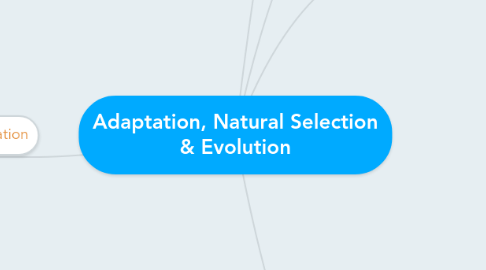
1. Speciation
1.1. A species is a group of organisms that can interbreed and produce fertile offspring
1.2. Speciation is the form of a new species
1.3. How it Works
1.3.1. Speciation occurs when a population splits and becomes isolated by an isolation barrier. The barrier between the sub-populations prevents interbreeding and gene exchange
1.3.2. Isolating barriers which prevent gene exchange can be geographical, ecological or reproductive
1.3.3. Mutations can occur randomly in sub-populations giving rise to new variation
1.3.4. Different selection pressures act on each sub-population
1.3.5. Natural selection occurs in each sub-population in a different way due to different selection pressures
1.3.6. Over a very long period of time, each sub-population has changed (evolved) so much, that they can no longer interbreed and produce fertile offspring with the other population
1.3.7. The sub-populations are now 2 different species. Speciation has occured
1.4. Examples
1.4.1. Darwin's Finches
1.4.1.1. The Galápagos Islands are volcanic islands
1.4.1.2. After the islands were formed, finches from South America arrived on the islands
1.4.1.3. The islands were relatively uninhabited so the finches made use of all the different types of food sources
1.4.1.4. Variation existed within the finches. Thin beaked finches probed into the tree trunks to eat insects, whilst the thicker beaked finches ate ground nuts
1.4.1.5. After a long period of time, the Galápagos finches had changed so much, that they could no longer interbreed and produce fertile offspring with the South American finches. They had become a new species
1.4.2. Cichlid Fish
1.4.2.1. Lake Victoria was massive lake containing of cichlid fish
1.4.2.2. Drought caused the lake to dry up and split and form several smaller lakes
1.4.2.3. The fish were isolated within each lake, and faced different selection pressures and struggles for existence
1.4.2.4. Variation existed within the fish, especially within the mouths of the fish
1.4.2.5. After a long period of time, the cichlid fish in each lake had changed (evolved) so much, that they could no longer interbreed and produce fertile offspring with the fish in the other lakes. They had become a new species
2. Adaptation
2.1. An Adaptation is an inherited characteristic that helps an organism survive
2.2. Form due to random advantageous mutations
2.3. Examples
2.3.1. Giraffe
2.3.1.1. Long neck - structural
2.3.1.1.1. Can reach high branches
2.3.2. Polar Bear
2.3.2.1. White fur - structural
2.3.2.1.1. Camouflages them while hunting
2.3.3. Sun Bear
2.3.3.1. Long tongue - structural
2.3.3.1.1. Can reach into trees or ant nests
2.3.4. Cactus
2.3.4.1. Spines - structural
2.3.4.1.1. Stops animals from eating them
2.3.5. Hedgehog
2.3.5.1. Spikes - structural
2.3.5.1.1. Stops predators from getting to them
2.3.6. Skunk
2.3.6.1. Sprays smelly gas - behavioural
2.3.6.1.1. Deters predators
3. Avoidance Behaviour
3.1. Avoidance behaviour occurs when an organism retreats to avoid danger
3.1.1. For example, a snail retreating into its shell to avoid danger
4. Habituation
4.1. Habituation is when an organism stops retreating to a harmless stimulus in order to save energy
4.1.1. For example, Prairie dogs retreat into their holes at the sound of approaching human footsteps. When this occurs many times and the prairie dogs know the footsteps are not a threat, they no longer retreat at the sound of footsteps
4.2. Short term behaviour
5. Natural Selection
5.1. How it Works
5.1.1. Organisms always produce more offspring than the environment can support
5.1.2. Variation exists within the species (due to different mutations)
5.1.3. Organisms struggle for survival and compete for space, food & mates
5.1.4. Those organisms better adapted to the environment survive as they have selective advantages. Those organisms less well adapted die off. This is Natural Selection
5.1.5. The surviving organisms then go on to mate, reproduce and pass on the favourable alleles that confer the selective advantage
5.2. Examples
5.2.1. Peppered Moths
5.2.1.1. Two forms of moths exist (light and dark form)
5.2.1.2. The light form of moths had a selective advantage as they were camouflaged against white lichens growing on trees so birds could not see them
5.2.1.3. Before the industrial revolution, there were lots of white moths but few dark moths as dark moths were easily spotted by birds
5.2.1.4. After the industrial revolution, lichens on trees died and trees turned black. Then the dark moths had a selective advantage and survived, mated and reproduced
5.2.2. Anti-biotics
5.2.2.1. Variation exists between the bacteria and due to random mutations, some bacteria are resistant to the anti-biotics
5.2.2.2. These resistant bacteria reproduce and can quickly produce a whole population of bacteria that are resistant

